Introduction
In early 2012, the World Bank issued a report on Europe’s growth model (Gill and Raiser 2012). Looking at six main elements of the model—trade, finance, enterprise, innovation, labor, and government—, we concluded, overall, that Europe’s growth model had worked well during the previous 50 years. Europe had brought two hundred million people from middle to high income through the forces of economic integration. European companies had generated productivity gains, exports, and jobs, and Europeans enjoyed lifestyles that were rightfully the envy of many around the world. But while Europe’s growth model was not broken, it needed improvement. European governments were slowing economic growth because they had become extremely large without becoming commensurately efficient. European labor markets and social security systems were struggling to adjust to the reality of an aging population. Too many European companies had failed to innovate, and Europe had left sizeable gains from integration in services—especially modern services—unexploited.
Europe’s growth model had worked well during the previous 50 years, bringing two hundred million people from middle to high income, and companies had generated productivity gains
We wrote that assessment at a time when Europe was grappling with an economic and financial crisis. Today, four years later, our assessment remains fundamentally unchanged. The countries in Europe that have come out favorably from the global economic and financial crisis are those that have harnessed the forces of economic integration well and have best addressed weaknesses in the organization of work and welfare. Europe’s economic model continues to benefit countries both at its core and periphery. Seeing these successes, it is not difficult to remain optimistic.
But not all countries are doing well, and their sluggishness does not help those that have been more diligent and dynamic. In understanding why the crisis has been so protracted in some parts of Europe, it is necessary to look beyond the deeper structural deficiencies emphasized in Golden Growth and to consider the role of money. In Golden Growth, we deliberately avoided a lengthy discussion of the common currency and all its complications because the scope of the study was broader—it included 45 countries, only 17 of which had the euro—and longer—it studied these economies during six decades, and the euro had existed in only the last one. Cyclical and structural factors are difficult to compartmentalize, however, and the Eurozone is a big part of the European economy. For now and in the foreseeable future, the European economic model is best understood as a combination of six components: trade, enterprise, finance, money, labor, and government.
The principal failure was not recognizing Greece’s difficulties as a sovereign solvency early on
Our interpretation of the Eurozone crisis emphasizes the underlying failure to achieve a real convergence, which made a crisis almost unavoidable in the event of asymmetric external shocks. However, design flaws and policy mistakes arguably made matters worse. The principal failure was not recognizing Greece’s difficulties as a sovereign solvency early on. In addition, European policymakers failed to sever the “doom-loop” between sovereigns and banks across the Eurozone (see also Baldwin and Giavazzi 2015).
This chapter expands and updates the 2012 Golden Growth analysis, illustrates the cases of post-crisis success and continued stagnation among Europe’s economies, and expands the original framework by complementing the discussion of finance with a section on money. Our recommendations for improving Europe’s growth model follow from the assessment of Europe’s strengths and weaknesses: trade and enterprise, finance and money, and labor and government.
Relatively few changes are required to the organization of trade and enterprise. As in 2012, there is the need to strengthen the common market in services and to make it easier for entrepreneurs to enter new markets, invest abroad, and grow their businesses worldwide. This will contribute to a restart of what we called Europe’s “Convergence Machine.” Europe
remains unique in having a mechanism by which poorer and newer members of the extended European Union can quickly get to the income and productivity levels of the more advanced EU core. This is Europe’s strongest and most desirable attribute, and it should be strengthened and extended to aspiring members in the Balkans and the East. It will require greater efforts in those countries that have neglected to create an attractive business environment, but it also requires a continued openness in the member states of the European Union.
More changes are needed in the two interrelated components of finance and money to insure Europe against the risks of fiscal-financial excess, especially in the Euro area. Several important steps have been taken. The most important is the establishment of a banking union to jointly supervise the Eurozone’s systemically important banks with a common backstop to prevent banking sector problems from becoming sovereign debt problems. New rules have also been issued to guarantee greater fiscal discipline in the European Union. But several challenges remain. The absence of a mechanism to allow sovereign default within the Euro area means that governments do not benefit from market signals in reinforcing fiscal discipline. The small size of the common banking sector backstop, in turn, means that the doom loop between banks and sovereigns has not been completely broken. Addressing these challenges would allow finance to reemerge as the lubricant of economic convergence across the EU, a role it played successfully in the East during the 2000s, but met with spectacular failure in the South.
Before the crisis, the biggest changes needed in Europe’s economic model were in the organization of labor and government. Developments during the last four years have made these changes even more urgent. With unemployment rates above 20 percent in many countries and public debt levels swollen both by chronic deficits and by the added burden of bank bailouts, a spotlight has been turned on Europe’s greatest weaknesses: labor and welfare. There are some encouraging signs, however. Labor market reforms have begun in Spain, Italy, and, more recently, in France. Labor mobility has been increasing steadily across the EU. Some European countries—most notably Germany—have shown an enlightened attitude towards migration in the face of their own demographic decline. But much more remains to be done, particularly to rein in excessive and unaffordable social welfare spending and to restore sustainability to public finances. Europe has prided itself on a lifestyle that balances work and leisure. For an increasingly large number of people in Europe—especially its youth—, this has become a distant aspiration. The organization of work and welfare will need deeper adjustments if Europe is to remain the world’s “lifestyle superpower.”
Europe’s economic model before the crisis—a scorecard
Europe’s economic model, fashioned and followed since World War II and progressively enlarged to cover much of the continent today, has distinct features. Perhaps more than others around the world, Europeans want economic growth to be smarter, kinder, and cleaner, and they are willing to accept less for “better” growth. Europe’s economies are also more mature and its societies older than those of most other regions. In both respects, Europe’s growth can be called “golden” (Gill and Raiser 2012). But, in parts of Europe, policies have deviated from growth’s “golden rule” as current generations have consumed more than they have saved, and debts have accumulated that risk weighing down the prospects for future generations. The challenges of debt and aging have motivated calls for radical changes in Europe’s economic model. Our analysis, four years ago, cautioned that in their zeal for change, Europeans should take care not to throw out the attractive attributes of their model together with the weaker ones. We start this article with a summary of our argument.
Three major achievements summarize the strong points of Europe’s economic model: (i) economic convergence has lifted millions of people above the threshold to high income; (ii) design and dexterity have secured Europe’s global economic heft; and (iii) the European way of life is admired and envied around the world.
The Convergence Machine
Europe has achieved unprecedented regional integration, and this has facilitated a process of economic convergence that is globally unique (Chart 1). Between 1950 and 1973, the incomes of 100 million Western Europeans converged rapidly towards those in the United States. In the subsequent two decades, another 100 million people in Southern Europe crossed the threshold to high income, following the same pattern of integration and convergence. Over the past 25 years, it has been the Eastern Europeans’ turn to benefit from Europe’s Convergence Machine. Today, another 100 million people in candidate countries in the Balkans and Turkey are aspiring to follow them.
Chart 1
Trade and finance are the two elements of Europe’s economic model which have been most closely associated with this achievement. In 2008, almost half of the world’s goods trade involved Europe. Compared with Asia, which has established itself as the world’s factory over the past two decades, European trade remains distinct. In Asia, China serves as the gateway to the world—other countries trade with China, and China ships goods to global markets. In Europe, while two-thirds of trade remains within the region, the new member states in Eastern Europe have seen their share of trade with traditional EU members progressively decline (Chart 2). Trade with the EU has made these countries globally competitive as their trade has become ever more sophisticated. FDI and offshoring, in turn, have made Western European companies more competitive. The challenge for European trade going forward is to deepen integration in services, particularly professional services, such as ICT, legal services, and insurance, but also in transport and energy sectors. Overall, trade is the most attractive attribute of Europe’s economic model.
Chart 2
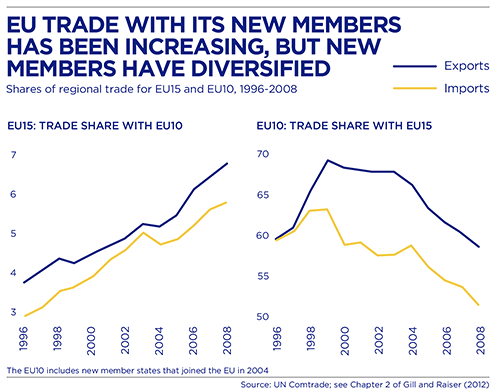
Finance has been the second pillar of Europe’s economic convergence. Economists have long been puzzled why capital in the world fails to flow systematically downhill. In other words, poorer countries have often exported capital, and those that have not done so have tended to grow less than those that have. This is not the case in Europe. The decade before the financial crisis saw an explosion of cross-border capital flows in the EU and its neighboring countries and—by and large—these flows have financed higher growth in Europe’s emerging markets and have contributed to convergence (Chart 3). But, as discussed further below, there have been excesses, and their correction has proven enormously costly, particularly in the Eurozone. In our assessment, four years ago, finance was seen as one of Europe’s strong points. This is still true in parts of the region. But, in others, primarily in the Eurozone and some of the countries of the Eastern Partnership, financial flows have masked the lack of real integration, have financed consumption and real estate booms rather than productive investments, and have left recipient countries with a huge debt overhang when the flows stopped. Below, we assess the changes made and the reforms still needed in the regulation of finance to ensure it remains a catalyst of convergence.
Chart 3
Brand Europe
Europe’s companies have become globally recognized for the high quality and elegant design of their products and services and—the recent Volkswagen scandal notwithstanding—admired for their social and environmental responsibility. This has given Europe a distinct brand and ensured that the continent continues to enjoy global economic heft. While nurturing the brand, European companies have delivered what was expected of them: productivity, jobs, and exports (Chart 4). However, this overall positive assessment of European enterprise is subject to considerable differentiation across various parts of the region. Productivity growth in the EU15 could have been faster (and, indeed, should have been faster to allow the EU15 to catch-up with productivity levels in the US), and employment growth in the new members states has been subdued.
Chart 4
But the biggest worry is about productivity patterns in Southern Europe since 2002. While Greece, Italy, Portugal, and Spain created plenty of jobs between 2002 and 2008, these were mainly in cyclical activities, such as construction, or in less productive micro and small enterprises. As a result, while productivity in the rest of Europe converged, enterprises in Southern Europe, on average, became less productive (Chart 5).
Chart 5
One reason for these developments in the Southern EU15 has been that regulations of product and labor markets have not been conducive to the creation of productive jobs (Chart 6). Red tape and onerous tax and labor regulations have discouraged companies from growing and kept them focused on domestic markets (Dall’Olio et al. 2013). Lack of internationalization has meant that enterprises in the South have benefited less from economic integration and have fallen behind in the attraction of FDI and the integration into global value chains. For a while, the massive inflow of financing was able to mask these weaknesses and may have aggravated them by pushing up wages and production costs in the deficit countries. Increasing competitiveness has thus been rightly at the center of structural reform efforts in Europe’s periphery since the global financial crisis, and in the most aggressive reformers, these efforts are starting to bear fruit.
Chart 6
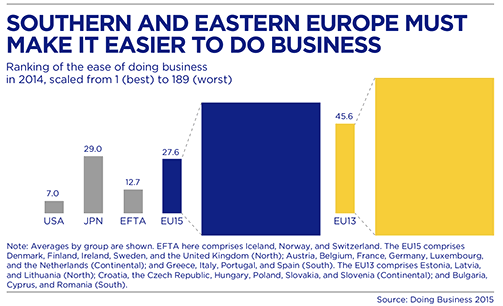
The Lifestyle Superpower
European workers are accorded strong protection against abuse by employers, and have unprecedented income security after job loss and in old age. Europe’s organization of work and government has made the European lifestyle admired and envied around the world. It has also been expensive. With only 10 percent of the world’s population, Europe accounts for over half of the world’s spending on social security, and European governments are larger than anywhere in the world (Chart 7).
Chart 7
As incomes have increased, Europeans have been able to work less and still enjoy rising standards of living. By and large, Europeans work fewer hours a week, fewer weeks in a year, and fewer years in their productive lives than they did in 1960. They also live a lot longer than they did 50 years ago (Chart 8). With aging societies, the pressure on social security systems is expected to increase even more going forward. In short, in many European countries, public pension systems have become unsustainable, and the burden of payroll taxes used to finance social security and health systems in Europe is already the highest in the world. The elderly are hardly better off for it. Southern EU15 countries, in 2007, spent around three times more as a share of their GDP on public pensions than the Anglo-Saxon countries (US, UK, Australia, New Zealand), but real public pensions in PPP US$ per retiree were only 15 percent higher. To maintain their lifestyles and sustain public finances, Europeans will have to retire later. Many already do, and the experience suggests this is good for them as well as their countries (Arias and Schwartz 2014; Bussolo et al. 2015).
Chart 8
In 2012, we gave Europe the highest marks for trade and finance, associated with Europe’s success in economic convergence. The lowest marks were received for the way European countries organized work and government, with the performance of the environment for business and innovation somewhere in between. Our recommendations were most extensive regarding reforms of labor markets, social security, and the management of public debt. Fewer changes were recommended to reform the business climate and innovation systems and fewer still in the regulation of finance and the deepening of the Common Market. However, developments during the last five years provide reasons to reassess the European growth model.
What has happened since the crisis?
Convergence in one part, divergence in another
The global financial crisis initially affected mostly countries in the European periphery, such as Ukraine, which saw their economies suddenly cut-off from international capital flows. But, in October 2009, when a new government in Greece revealed that previous fiscal accounts had been fudged to hide the true size of the deficit, the crisis spread to the European Union, especially to the Eurozone. The mechanics of how the crisis spread were the same in the Eurozone and in emerging markets (Baldwin and Giavazzi 2015). Concerns about a country’s ability to repay its foreign creditors led to a sudden stop in capital flows, necessitating deep adjustments in external balances. The effect of the crisis on the banking sector of deficit countries and through the banks on public debt sustainability acted as a massive amplifier, particularly in the Eurozone. But at the heart of the crisis were divergences in competitiveness that needed to be redressed. Without the ability to devalue, deficit countries in the Eurozone were forced into sharp austerity.
In this section, we examine developments in Europe since 2008, looking first at economic performance and the extent to which adjustment and structural reforms have helped close the competitiveness gap across Europe.
The European Convergence Machine after the Crisis
Europe’s economic performance since 2008 has been lackluster as a whole. Real GDP barely exceeds the peak reached in 2007 in most countries in the region. However, there has been considerable regional variation (Chart 9). The new member states of Eastern Europe recovered more quickly than the European core and have continued to converge since 2009. Indeed, the largest among them—Poland—never experienced a recession, and its GDP in 2014 stood fully 21 percent above the level of 2007. The Baltics saw a dramatic fall in output and a similarly dramatic turn-around as they slashed public spending and real unit labor costs, thereby eliminating external imbalances that had exceeded 10 percent of GDP within just two years and restoring access to market financing. Bulgaria and Romania have continued to grow at rates above 3 percent since 2010. It is in the EU15 South that overall performance has continued to diverge, with median GDP now some 10 percent below the 2007 peak.
Chart 9
The picture is not very different if we look at labor productivity growth since the crisis (Chart 10): sluggish growth of around 1.7 percent in the EU15 North and Core, an expansion around twice that rate in the EU13, and negative productivity growth on average in the EU15 South, with significant declines in Greece and Portugal.1
Chart 10
With declining or sluggish productivity, adjustment in competitiveness has had to come through declines in wages. Real unit labor costs have declined between 15 percent in Spain and Portugal and 20 percent in Greece and Ireland since their peak, and today they have returned to levels in the early 2000s (IMF 2015). Current account imbalances have been largely eliminated, with swings of over 10 percent of GDP in Greece and Portugal and 5 percent in Spain (Chart 11). Adjustments have also been significant in parts of the new member states. However, a parallel adjustment has failed to take place in the surplus countries, most notably Germany. This has led to criticism that the costs of adjustments have been born only by the deficit countries. While Germany would help economic rebalancing in Europe with more robust domestic demand, it is wobbly investment rather than subdued consumption that is holding Germany back (Schmieding 2015). This reflects deleveraging in the banking sector and is unlikely to be helped by attempts to erode Germany’s relative competitiveness (although more public investment spending would clearly help both Germany and its EU partners). Instead, countries in the Eurozone periphery will have to reform to make their economies more attractive and their businesses more productive.
Chart 11
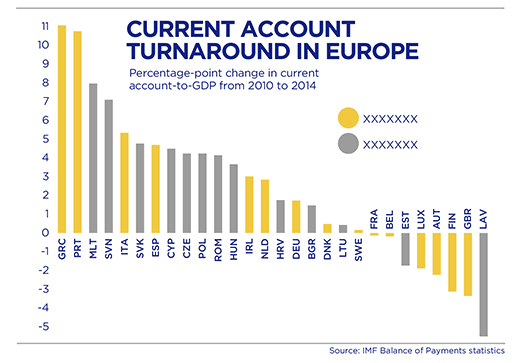
A lot of this is already happening. Eastern Europeans have continued to lead the way in making their business environments friendlier, but Greece, Portugal, and Italy have also made an effort (Chart 12). According to the OECD, Greece, Portugal, Ireland, and Spain are the top four countries when it comes to implementing reform recommendations (OECD 2015). This is true not only for the business environment, but labor markets are also being reformed and made more flexible. According to OECD’s employment protection legislation (EPL) index, the EU15 South now has more flexible labor markets than the EU15 core (Chart 13). Germany’s labor market reforms of 2003 are often cited as an example of the benefits that come with lowering hiring costs and moving from a system job protection to one that incentivizes job search while providing temporary income security to the unemployed. Labor market reforms are working in the South, too. By the end of 2014, unemployment was down 1.4 million in Greece, Ireland, Portugal, and Spain, a decline by 16 percent from the peak in early 2013. Except in Portugal, employment growth in the other three countries in 2014 was running at almost twice the rate as in Germany. 2
Chart 12
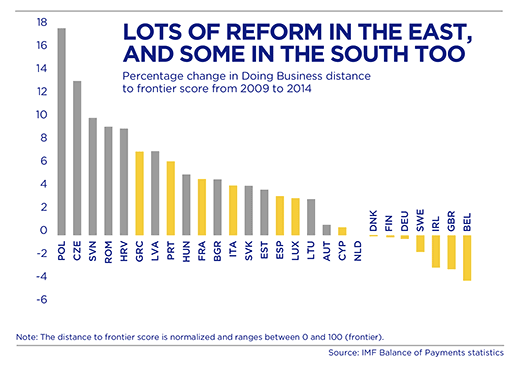
Chart 13
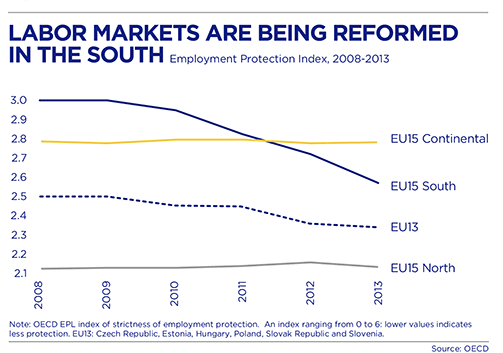
When we published Golden Growth, we said it would not be difficult to restart Europe’s Convergence Machine. The evidence suggests to us that optimism was justified. Adjustment is happening faster in the countries that started to reform earlier, such as the Baltics, and less painfully in those that went into the crisis with a stronger structural position, such as Ireland and Spain. Reforms of the Common Market, particularly its extension to services, have proceeded less rapidly, but with the pressure of a possible trade agreement with the United States and the evident need for more harmonious regulations in sectors such as finance and energy, here too progress is likely.
It is on the periphery of the European Union, in the western Balkans and in Turkey, and even more in the countries of the Eastern Partnership that the European Convergence Machine has continued to splutter. Without clear accession prospects, for instance, structural reforms in Turkey have largely come to a standstill (see Acemoglu and Ucer 2015, in this volume). Growth in the western Balkans remains well below levels in the EU13, and prospects are marred by recurrent political instability. Literally torn between Russia and the EU, the countries of the Eastern Partnership have benefited from neither European nor Russian investment and have been shattered by war, scandal, and capital flight. We hope that the signs of recovery in Europe’s economy and the evidence that the Convergence Machine still works will encourage politicians in both the EU and in its neighborhood to redouble their efforts at closer economic integration and ultimately re-open the process of EU enlargement. The Common Market remains Europe’s most attractive attribute and its most successful policy.
Financial integration and the Euro
When the Euro was created, many expected it to yield dual benefits: it would make doing business less costly across the Eurozone and thus enhance economic integration, and it would provide a macroeconomic anchor for its weaker members, forcing them to maintain fiscal discipline and to keep the economies competitive. However, others warned that the Eurozone did not fit the requirements of an optimum currency area. Specifically, Europe’s rigid labor markets were seen as a major risk since they would make adjustment much more difficult in case of an asymmetric shock. Indeed, labor mobility in Europe has remained among the lowest in any advanced country.
The crisis in the Eurozone has confirmed the views of the skeptics. The Euro did catalyze an enormous increase in cross-border financial flows and a resulting rapid convergence of borrowing costs, but it did not lead to greater real integration (Sugawara and Zalduendo 2010). The business cycles of countries in the Eurozone periphery did not become more synchronized with the core, and trade integration did not increase by much. In the EU15 South, convergence in per capita incomes also stalled in the 2000s. Labor market mobility remained low throughout the EU. Cross-border flows exploded but financed mainly unsustainable consumption and real estate booms. When Eurozone investors started questioning the ability of borrowers in other countries to repay, capital flowed out, yields went up, and the deficit countries—unable to devalue—were forced into a painful economic adjustment (Chart 14).
Chart 14
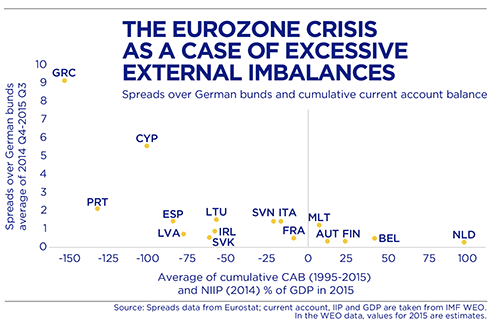
The experience in the new EU member states was quite different. Here, too, the first decade of the 2000s saw significant capital inflows. However, these flows facilitated both nominal and real integration (or at least did not reduce the level of real integration). When the tide turned, these countries, even those that had joined the Euro (Slovakia) or fixed their exchange rates to the Euro (Bulgaria, the Baltics), were able to adjust with much lower costs in terms of output and employment.
What accounts for these different experiences with financial integration? One reason has to do with the greater structural flexibility of the new member states, as reflected in generally better scores in the quality of the business environment, for instance. A second explanation is that the nature of the capital flows was quite different. Within the Eurozone, much of the cross-border flows were intermediated by banks, whereas other parts of the region saw greater reliance on equity flows (Chart 15). When the tide turned, much of the earlier banking sector inflows were reversed (Chart 16).
Chart 15
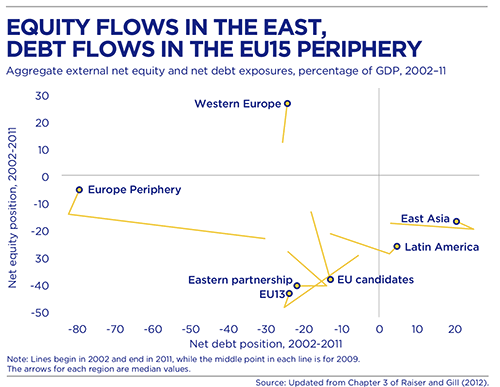
Chart 16
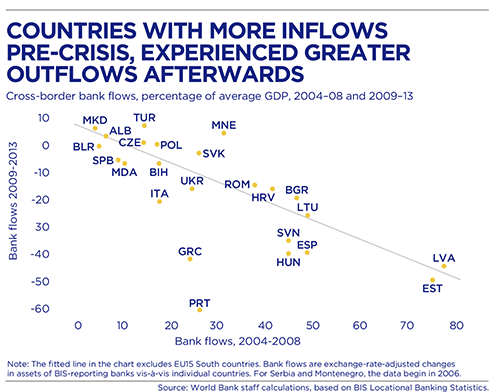
Equity flows involve a greater degree of risk sharing between investor and investee than debt flows do between creditor and borrower. They are thus inherently less easy to reverse. But within the Eurozone, several factors served to amplify the negative effects of excessive banking sector leverage. First, much of the cross-border lending was bank-to-bank lending. Total lending by banks in the core Eurozone countries to Greece, Italy, Ireland, Portugal, and Spain increased by a whopping 1.5 trillion Euros in the decade after the introduction of the Euro, or some 340 percent. Without Italy, the increase was 1 trillion Euro, or 495 percent (Baldwin and Giavazzi 2015). This was a significant accumulation of bank debt in both the lending and receiving countries.
However, the supervision of banks as well as national safety nets to protect depositors and prevent a bank run were left to the responsibility of individual countries. When the bubble burst, debtor country governments stepped in to save their financial systems. The resulting increase in public sector liabilities pushed governments in Ireland and Spain over the edge of debt sustainability, despite their strong fiscal positions pre-crisis.
Second, in the case of Greece and, to a lesser extent, Portugal, domestic banks were heavily exposed to their own governments. When Greece revealed, in October 2009, that its fiscal deficit was over 12 percent of GDP, investors started to question the government’s ability to repay. When the first bail-out was agreed in mid-2010, Eurozone governments decided against Greece going to the IMF. Greek debt to commercial banks in France and Germany was exchanged for debt to public creditors—principally the ECB and the European Stability Mechanism. This failed to stem concerns over public debt sustainability, and contagion thus spread from Greece to Portugal, Ireland, Spain, Italy, and, for a while, even to Austria, Belgium, and France.
Rising yields on public debt of the affected countries made concerns over debt sustainability a self-fulfilling prophecy. Financial markets fragmented as rising public sector yields drove up private borrowing costs and capital flooded out of all periphery countries, leaving both solvent and insolvent borrowers without access to liquidity (Gill et al. 2014). Only with ECB President Mario Draghi’s “whatever it takes” speech, in August 2012, did calm gradually return to the Eurozone’s public debt markets and eventually to its financial markets. As of mid-2015, sovereign spreads have converged again, corporate spreads have followed suit, and net banking flows to the non-financial sector have turned positive for the first time since late 2011.
Policy mistakes and design flaws combined to push the Eurozone further into the debt vortex. It can be argued that Ireland would have been better off to force creditors to share the burden of adjustment, as was done by Iceland, for example. It can also be reasoned that if Greece had been forced into a traditional IMF-led adjustment and debt restructuring program early on, the contagion across Eurozone debt markets might have been better contained.
Going forward, the doom loop between banks and sovereigns needs to be broken, and the supervision of European banks needs to be strengthened to risk-proof financial integration. European banks also need to be encouraged to deal proactively with the stock of non-performing loans (NPLs). Important steps have already been taken through the creation of the Single Supervisory Mechanism under the ECB (accounting for around 80 percent of all Eurozone banking sector assets), the stress testing of European banks, the creation of a Single Resolution Fund (SRF), and the agreement for the European Stability Mechanism to directly recapitalize systemically important banks. However, the combined resources of the SRF (Euro 55 billion) and ESM recapitalization (up to Euro 60 billion) are still small relative to the size of the Eurozone banking sector (Euro 22 trillion). While deposit insurance has been harmonized, no central deposit insurance fund exists. Whether these measures would be enough in case of another systemic crisis is not clear (IMF 2015).
The Lifestyle Superpower and fiscal adjustment
In 2012, we argued that Europe’s biggest adjustment needs were in the labor market and in the size and effectiveness of government. While some progress has been made in labor market reform (see above), the financial crisis has accentuated the challenge of fiscal adjustment. As of 2015, only 10 of the 28 EU member states are likely to meet the Maastricht criterion of less than 60 percent public sector debt to GDP (Chart 17). Based on 2010 debt levels and structural fiscal balances, we estimated fiscal adjustment needs to range between 0.7 and 7 percentage points of GDP annually just to bring debt levels below 60 percent of GDP in Western Europe and 40 percent in emerging Europe (Chart 18). Add the cost of future health and public pension spending due to aging, and these numbers increase to between 4 and 11 percentage points of GDP across the region.
Chart 17
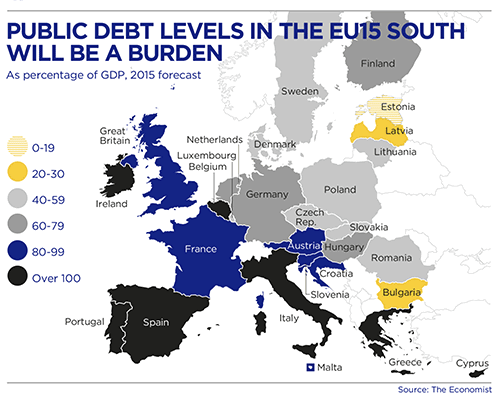
Chart 18
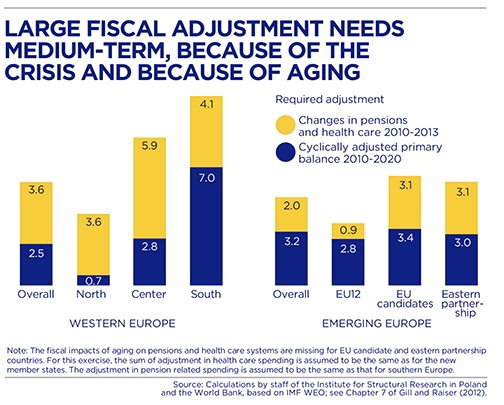
Public pension systems pre-crisis were already the main reason why governments in Europe were larger than elsewhere. The effect of the crisis has further increased the share of social security spending in GDP in most parts of Europe, most significantly in the Southern EU15 and in the new member states of Central Europe (Chart 19). Public pension spending will increase further as old-age dependency rates increase. The most effective way to keep future pension deficits in check would be an increase in the effective rate of retirement. Reductions in pension benefits and the encouragement of complementary private savings would also help. The inflow of migrant workers can temporarily smooth the increase in old-age dependency rates, but unless sustained perpetually, it will not prevent the effects of aging (Arias and Schwartz 2014). Europe prides itself on the balance it has found between work and leisure. As Europeans get older, they will have to balance leisure and work throughout their adult lives, not just until their early 60s.
Chart 19
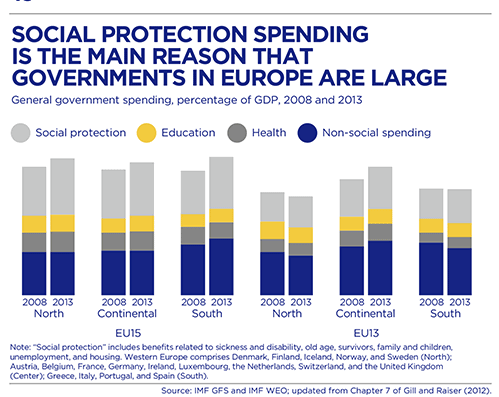
In the meantime, there is little alternative to greater fiscal discipline in the countries that allowed government spending to balloon pre-crisis (Greece, Ireland, Spain, the United Kingdom, and, to a lesser extent, Portugal). In Ireland, Spain, and the United Kingdom, this was hidden thanks to buoyant real estate linked tax revenues. But real spending in all three countries increased by close to 50 percent between 2000 and 2009, compared to less than 15 percent in Germany and Italy (Chart 20). The subsequent adjustment essentially brought spending back to pre-crisis levels, with the exception of Greece, where it declined to the level of 2002, and the UK, where it has not declined by much.
Chart 20
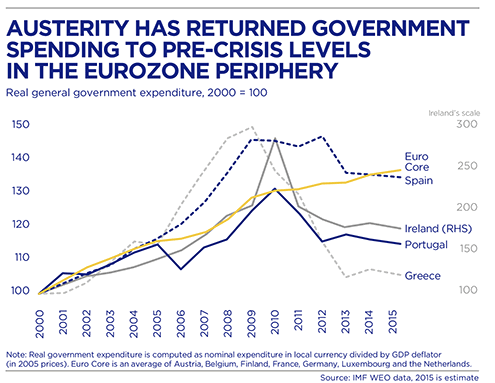
While the speed of adjustment in the EU15 periphery is remarkable, its extent is perhaps less calamitous when seen in context of the dramatic pre-crisis increase in spending. Nonetheless, concerns have been raised over the pro-cyclicality of austerity (Benassi-Quere 2015) and the impact of declines in public investment on future potential growth. There is some evidence supporting these concerns. The aggregate fiscal stance in the Euro area has been mostly pro-cyclical, as fiscal adjustment coincided with a growing output gap after 2010. Moreover, across the Eurozone, the countries with the largest fiscal adjustment during 2010 to 2015 were also those with the largest output gap (Chart 21). Correspondingly, public investment has declined by between 15 percent per annum in Spain and Cyprus, 10 percent in Ireland, Italy, and Portugal, and around 5 percent in Greece. On the other hand, public investment has been essentially flat in the Eurozone core and most of the Nordics, which have fiscal space and face record low borrowing rates that should make public investment attractive.
Chart 21
As of 2015, the aggregate fiscal stance in the Eurozone has become neutral. The pro-cyclicality of spending patterns across the Eurozone has also become less pronounced (IMF 2015). With recovery on the horizon for almost all countries in the region, the time may have come to leave the debate of growth versus austerity behind and begin the challenging task of long-term repair of public sector balance sheets. This is important for all European countries. In the Eurozone, it is imperative. To facilitate this process, the framework for fiscal governance in the EU has been repeatedly revised. The resulting architecture now includes a criterion for net expenditure growth to remain in line with trend GDP, nationally differentiated rules for the structural fiscal balance and its change year on year, and a criterion for the pace of adjustment of public debt, in addition to the nominal deficit and public debt level criteria that were part of the 1997 Stability and Growth Pact (SGP).
The framework is complex, and some of the targets are mutually inconsistent (Andrle et al. 2015). National requirements, not all of which are consistent with the requirements of the SGP, further complicate the picture. Finally, concerns remain over the measurement of several of the targets, particularly those relying on estimates of underlying or projected growth. Simplification of the framework would likely facilitate monitoring and enforcement and may help reduce output volatility going forward.
Whatever the fiscal rules, reestablishing long-term fiscal sustainability will require reductions in spending in many countries. This need not come at the cost of a reduction in the quality of public services. Countries such as Sweden and Estonia have demonstrated how public spending can be reduced through administrative reforms and changes in social security arrangements without affecting public service delivery. Turkey has shown how to escape rapidly from a public debt overhang and use the resulting fiscal space to expand public services (Raiser and Wes 2014). The vast differences in health spending between the US and France (with minor differences in health outcomes) and similarly striking differences in education outcomes in Finland and Italy (with similar spending levels) are suggestive of the scope for quality improvements and efficiency gains in key public services. Many Europeans would rather trade lower growth for a higher quality of life. Without sustainable public finances, they may end up with neither. If they trim their governments and make them more efficient, they can have both.
Restoring the luster of the European economic model
Europe’s economic model has brought numerous benefits to Europeans since World War II. In the face of Europe’s biggest economic crisis, it is worth remembering its achievements. In our 2012 report on the European model, we suggested that to keep what it had achieved, Europe needed to improve, not discard, its economic model. Our views have not substantially changed since.
The smallest improvements are required to restart Europe’s Convergence Machine. As this article has shown, the machine never stopped working for the new EU member states, but it is spluttering in Europe’s periphery, among the accession countries and the Eastern partnership, and went into reverse in the Eurozone. Structural reforms to make their economies more flexible are now helping Ireland and Spain rediscover their economic mojo, while Portugal has regained market access, and sentiment in Italy is turning up. Growth may finally return to all countries in the Eurozone, with the exception of Greece, which is suffering the effects of a botched bailout and political brinkmanship.
Much of the recent news is encouraging. But Europe could do more to strengthen economic momentum, including in the core economies. In France, tackling labor market rigidities and social security imbalances may be the highest priority. Germany could do more to boost public investment (Enderlein and Pisani-Ferry 2014), including improvements in education. All EU countries could do more to deepen the Common Market, particularly in services, and to reignite economic integration and, ultimately, the accession process with their neighbors to the South and East. The prospect of convergence through deeper integration is perhaps Europe’s biggest attraction, and it should be nurtured.
Private finance has contributed significantly to economic integration and convergence. But the crisis revealed serious flaws in the way banking was regulated, particularly in the Eurozone. Risk-proofing financial integration will require further strengthening Europe’s common supervisory architecture for systemically important banks and fortifying the firewalls between banks and sovereigns. Europeans have become increasingly skeptical of shared responsibility. This is one area where they should overcome their hesitation. It will be easier to convince voters in surplus countries to accept greater risk sharing if it goes hand in hand with further efforts in the deficit countries to improve their competitiveness and to restore long-term fiscal sustainability.
Fixing public finances and reforming work and government remain Europe’s most tricky challenges. In the short term, remarkable efforts have been made, from Greece and Ireland to Latvia and Bulgaria, to bring public spending into sink with economic potential. More could have been done in countries with the required fiscal space to ease the adjustment, in particular through greater public investment. But unless we believe that interest rates will remain low for a very long time, some fiscal adjustment will be required in almost every European country. Governments should make good use of improving economic conditions to implement difficult reforms, particularly to public pension systems. Many Europeans today live much longer and healthier lives than their parents. It is not clear why they should spend many more years in retirement, when they, in fact, have the skills, the experience, and often the desire to remain attached to the labor market.
Much can be learned from inside and outside Europe on how to tackle Europe’s challenges (Iwulska 2012). The post-crisis years have added a few more successful experiences to this list: Spain’s labor market reforms; the Baltics’ experience with adjustment under fixed exchange rates; Portugal’s patient consolidation of its public finances; Ireland’s success in export-led recovery at a time of a global trade slowdown; and, of course, the growing evidence in favor of unconventional monetary policies, including in the Eurozone, and perhaps particularly since 2012. Europe’s luster can be restored if policy makers build on these experiences. Europe’s economic model was already distinct before the crisis. By deepening the Common Market, fixing the financial system, and restoring discipline and sustainability to public finances, European policy makers can make the model distinguished.
Notes:
1 The substantial increase of productivity in Italy reflects developments in manufacturing, which saw an increase in value added and a substantial reduction in employment. As noted in Dall’Olio et al. (2013), Italy represents an interesting case, with a highly productive and competitive manufacturing sector in the northern part of the country, and a large tail of very unproductive micro enterprises in the rest.
2 Greece was dragged back into recession by the brinkmanship and resulting erosion of confidence of the new government in early 2015.
BIBLIOGRAPHY
Acemoglu, D. and M. Ucer. 2015. “The Ups and Downs of Turkish Growth, 2002-2015: Political Dynamics, the European Union and the Institutional Slide.” Article prepared for this Volume.
Andrle, M., J. Bluedorn, L. Eyraud, T. Kinda, P. Koeva Brooks, G. Schwartz, and A. Weber. 2015. “Reforming Fiscal Governance in the European Union.” IMF Staff Discussion Note 15/09. Washington.
Arias, O., and A. Schwartz. 2014. The Inverted Pyramid. Pension Systems Facing Demographic Challenges in Europe and Central Asia. The World Bank. Washington DC.
Baldwin R., and F. Giavazzi. 2015. The Eurozone Crisis. A Consensus View of the Causes and a Few Possible Solutions. A VoxEU.org eBook. Center for European Policy Research. London.
Benassi-Quere, A. 2015. “Maastricht Flaws and Remedies.” In The Eurozone Crisis. A Consensus View of the Causes and a Few Possible Solutions, edited by R. Baldwin, and F. Giavazzi, 72-84. A VoxEU.org eBook. Center for European Policy Research. London.
Bussolo, M., J. Koettl, and E. Sinnott. 2015. Golden Aging. Prospects for Health, Active and Prosperous Aging in Europe and Central Asia. The World Bank. Washington DC.
Dall’Olio, A., M. Iooty, N. Kaneira, and F. Saliola. 2013. “Productivity Growth in Europe.” World Bank Policy Research Working Paper 6425. Washington DC.
“Doing Business.” 2015. The World Bank. Washington DC.
Enderlein, H., and J. Pisani-Ferri. 2014. Reforms, Investment and Growth. An Agenda for France, Germany and Europe. Report to the Minister of Economic Affairs and Energy of Germany and the Minister for the Economy, Industry, and Digital Affairs of France. Berlin and Paris.
Gill, I., and M. Raiser. 2012. Golden Growth: Restoring the Luster of the European Economic Model. The World Bank. Washington DC.
Gill, I., N. Sugawara, and J. Zalduendo. 2014. “The Center Still Holds: Financial Integration in the Euro Area.” Comparative Economic Studies 2014, (1): 1-25.
International Monetary Fund (IMF). 2015. “Euro Area Policies.” IMF Country Report 15/204. Washington DC.
Iwulska, A. 2012. “Country Benchmarks.” Background paper prepared for Golden Growth. Available at: www.worldbank.org/goldengrowth.
Organization for Economic Cooperation and Development (OECD). 2015. Going for Growth. Paris.
Raiser, M., and M. Wes. 2014. Turkey’s Transitions: Integration, Inclusion, Institutions. The World Bank. Washington DC.
Schmieding, H. 2015. “Cruising Speed Despite Grexit Risk.” Berenberg Economics Global Outlook. London.
Sugawara, N., and J. Zalduendo. 2010. “How much economic integration is there in the extended EU family?” ECAnomics Note 10/1. Office of the Chief Economist, Europe and Central Asia Region. The World Bank.
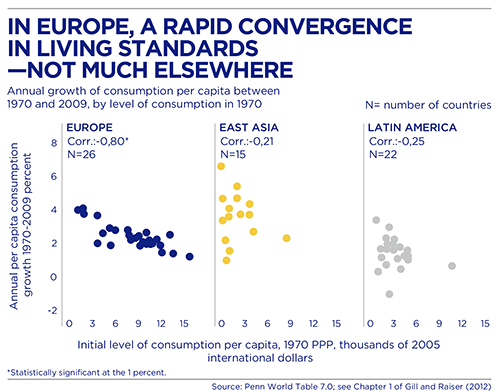
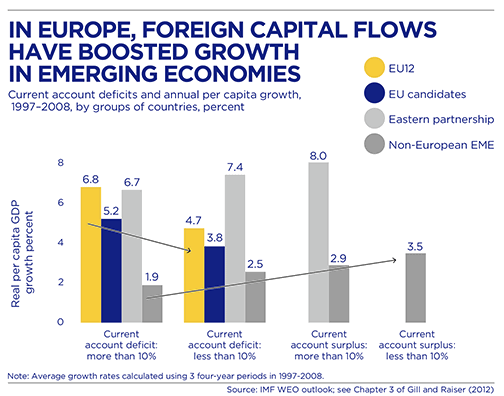
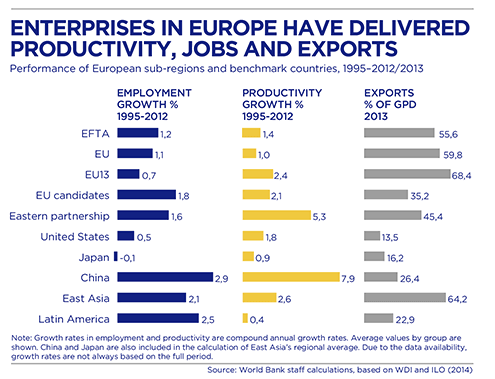
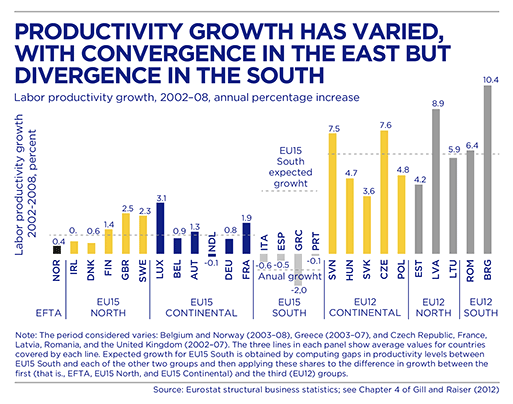
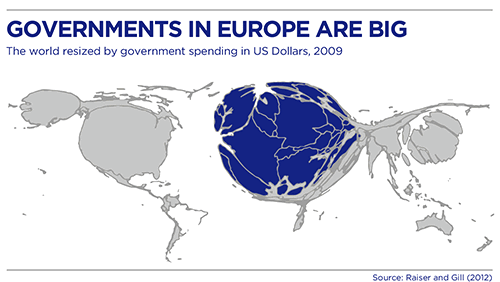
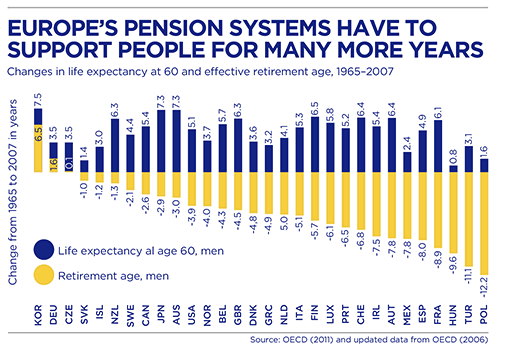
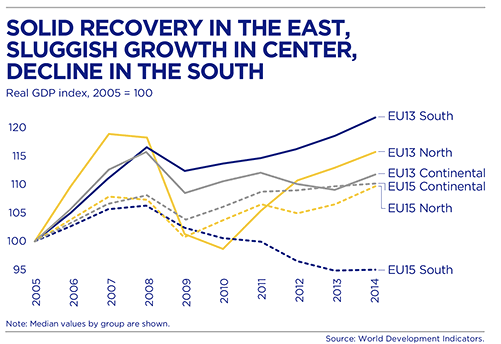
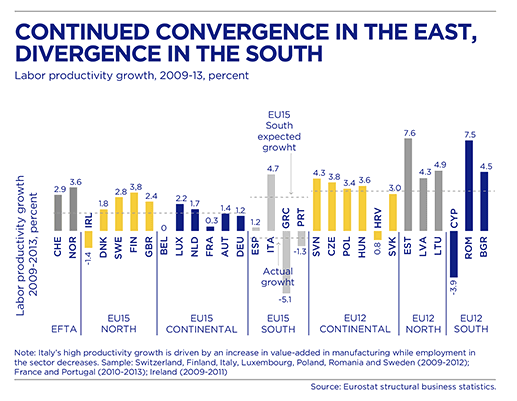
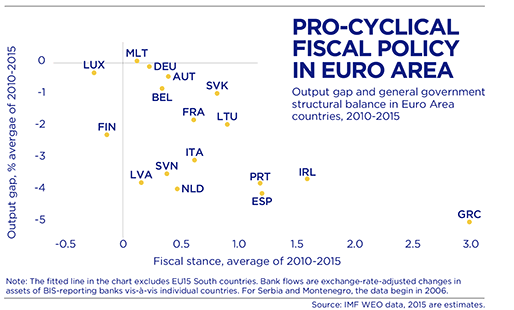
Comments on this publication